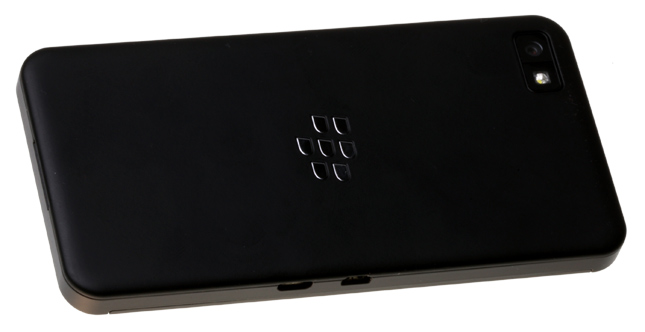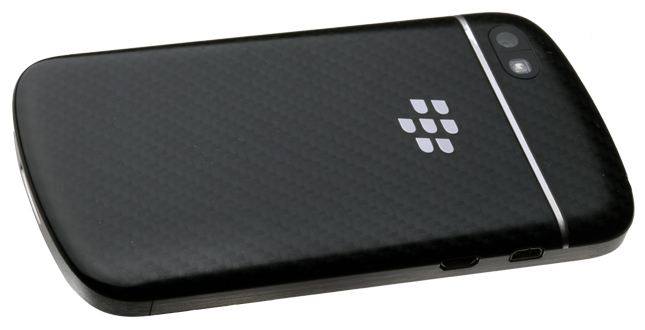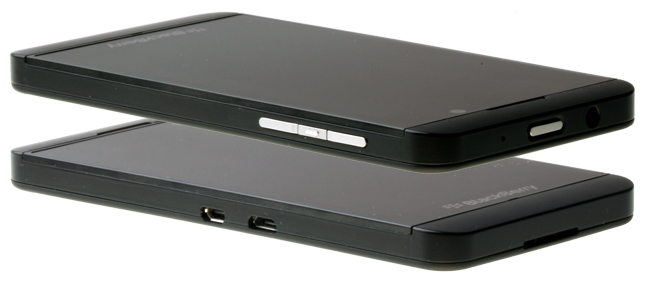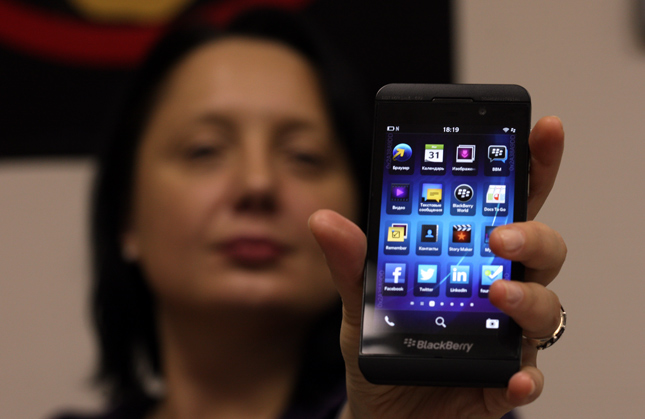BlackBerry Z10 - face with charm
New platform from RIM is fresh, and it has its own charm. And the intuitive interface is generally a breath of fresh air after Android! Parse step by step on the example of the new flagship.

Prehistory
In April 2010, RIM acquired QNX, the developer of the same-name Unix platform with a closed code. This platform has been used for more than thirty years in various industries requiring high reliability: space, hydropower, and the oil industry. By the way, more than 60% of automotive infotainment systems run on QNX. In general, for about three years the company has been developing a hybrid operating system that combines the best qualities of the BlackBerry and QNX platforms. At one time, the BlacBerry 9900 smartphone (May 2011) appeared on the BB7 platform, and the Playbook tablet (June 2011), which already worked on QNX. They should have been combined in the company.
')
Let me remind you that the system was originally named BBX - from the connection of the brand names BlackBerry and QNX, but later it turned out that this name was already used by BASIS, so the new platform was simply called BlackBerry 10. After that, a year later, in March last year, the conference was held for BlackBerry Jam developers in Orlando, where I was also and saw a gadget that was distributed to developers so that they could test BlackBerry 10 programs on it. - RIM understood that it was very important that there were as many programs as possible. This gadget - BlackBerry 10 Dev Alpha was not intended for sale and in essence was a BlackBerry Playbook, but packaged in a more compact package.
After that, during the year, various information leaks from the company took place - for example, snapshots of a mysterious device with the code name London, allegedly first on the BlackBerry 10, got into the network. The platform itself had to start on October 10, but the announcement was postponed. And during the waiting period, RIM was buried several times: the company laid off seven thousand employees last year, revenues in the third quarter collapsed by 47% compared to 2011, BlackBerry’s share in the smartphone market fell to 4-5%, and for the first time in history The BlackBerry subscriber base decreased by 1 million, from 80 to 79. Just before the announcement of BlackBerry 10, the company's president, Torsten Heins, who holds his post for exactly one year, reported on the possible sale of the iron division, and immediately allegedly intended to buy it from Lenovo. However, the latest news only raised the company's shares.
Finally, on January 30, Research in Motion officially announced BlackBerry 10. And also the first two smartphones on this system - the BlackBerry Z10 and the BlackBerry Q10. One is fully touch, and the second one has a hardware keyboard in the good old style and, accordingly, a smaller, square screen. For the stuffing, the Z10 and Q10 are identical, but the screen resolution of the Z10 is 1280x768 pixels, and in the Q10 - 720x720. It is clear that the main focus will be on the Z10 - touch screens are the main trend and main challenge of the BlackBerry, and the QWERTY-smartphone is rather a tribute to the past and a designation of loyalty to its fans. So we will study the BlackBerry Z10 - which, as it can be seen, is the very device called London, whose image has leaked into the network.

Blackberry z10


Blackberry q10

First look
So, how does BlackBerry 10 want to surprise, how does this platform differ from competitors? Firstly, it is immediately obvious that there are no buttons here - neither hardware nor touch, unlike all dominant platforms. Let me remind you that in iOS there is a hardware button to return to the home screen, in Android there is a whole menu, while Windows Phone also has a series of touch buttons. Obviously, the system is controlled by gestures from the edges of the screen, and this industry has seen at least twice - in the MeeGo platform, as well as in the BlackBerry Playbook tablet. Here, the majority of actions are performed by a single gesture: a movement from the logo upwards.
But more about that later, but for now - the hardware. The device is quite thin, but rather big, not the easiest, but it is pleasant in the hand. The screen is quite trendy, 4.2 inches, 1280x768 dots, this is a density of 356 dots per inch, clearer than in the same iPhone5.
The connectors are almost all the same as in the development sample: the power button, Reset and standard audio jack, volume control and Mute; and on the left side - microUSB and microHDMI. But unlike the developer sample, there is a removable battery, and the microSIM is inserted inside. The back cover, by the way, is different, there is no soft-touch, but material that is close to what is used in the Bold 9900. I compare the X10 and the Blackberry Bold 9900: very similar devices, and RIM rightly took their best QWERTY smartphone.
But if the Bold 9900 screen had a 2.8 inches diagonal and a resolution of 640x480, then in Q10 the resolution was 720x720.
However, at the ends of both gadgets there are no contacts for the docking station, which were, for example, on the tablet, which is a little sad.
There are two cameras, 8 and 2 MP, and the main one supports the time-shift function, which I will talk about a little later. There is NFC and support for 4th generation networks, with two versions - both HSPA and compatible with Russian LTE networks. 16 GB internal memory. Dual-core processor at 1.5 gigahertz, 2 GB RAM. There will be two versions of each device, in white and black case.


We work with a finger
The screen is activated by moving your finger from the logo to the top. This is the first situation when the phone does not need to be fully turned on, a sort of half-wrist. In this mode, you can see, for example, time, battery charge, or message status. This semi-movement is called peek in English - as if you are peeping. You can swipe down and the screen turns off again. And if you hold your finger higher - the menu will start.
The same action, the peek half-shift, can be performed in various applications. For example, while I was surfing, the LED beacon blinked at me that a message had arrived, I pushed the picture back, looked at what had fallen off me, and either came back or switched to messages.
Blackberry hub
Message management is another interesting feature called the BlackBerry Hub. Here all incoming messages are collected in one place: mail, Facebook, BBM, Twitter, Linkedin and so on, messages can be filtered by type, for example, only Twitter can be read. But the hub allows you not only to view statuses, but also to respond to messages and publish your statuses. So, to respond to a message, you need to hold the context menu, from where various functions are available. And from here I can publish my status without launching the application separately, in this case Facebook. I note that this is not a separate program, but a part of the system: first, in the settings, you drive in all your data in social networks and receive a hub. Also in the hub there is a calendar - pull it down, and information about the next meeting will appear.
Job
QNX, on whose core the system is built, is distinguished by high reliability primarily due to the multithreading of processes. An incorrectly working application cannot hang up or drop the system - you can simply close it; this is done by clicking on the cross. The work of eight applications is supported simultaneously, all of them can be seen in the menu and switch between them. And the application from which you came out is always displayed in the upper left corner - so that you do not get confused. Clicking on the cross completely closes the application and clears it from memory. If you run the ninth application, it will push out what was closed first. Running eight applications at the same time is not a limitation of the system itself, QNX can stably hold many more programs, just BlackBerry thought that eight applications running simultaneously are enough, and you make fewer clicks: you see all the programs running on two screens, you don’t have to scroll far and climb inside.
Typing
In general, in BlackBerry 10 a lot has been done to ensure that the user does as little as possible of unnecessary clicks and movements, and work with the text also confirms this. The appearance of the on-screen keyboard is very similar to the hardware keyboard: the same gaps between the horizontal rows, the most enlarged keys close to the screen, the inverse colors — white letters on a black background, well, just like on BlackBerry devices. The system guesses words and gives hints. You can print without any spaces: the system will arrange them itself, just press the space at least once. And it is on the space that the hint is displayed. Russian dictionary is connected, everything works with a bang. In English, switch to the left of the space in two clicks. To erase a word, you just need to wipe the keyboard on any place to the left, and it will be erased by the word. The keyboard can be removed, and that she returned - just click anywhere on the screen.
Browser
BlackBerry 10 is considered to be the coolest browser in the world that works best with HTML5. Built browser on the webkit engine. To test this, I launched the famous HTML5 compatibility test. The browser scored 485 points, and in this indicator overtook all existing mobile browsers, even tablet and desktop.
Blackberry balance
Another trick is especially for business users: with the BlackBerry Balance function configured (and configured by the administrator on the BES server), you can separate the business and personal spaces of your smartphone. One down movement from the center of any screen is enough.
BlackBerry Balance separates corporate information from personal information - you can give a smartphone to a child without the risk that he will delete something, for example, in work mail. Both applications and data are divided, of course, all this can be customized. And when you, suppose, change jobs, only corporate data will be deleted, without affecting personal data. This trend is today called the BWOD Bring Your Own Device, when people want to use their personal smartphones and at work, you can set up BlackBerry Balance for them.
Camera
The camera writes video in HD mode, but the main feature is the built-in timeshift function, which allows you to literally open people's eyes and return smiles to them. The essence of the function is that the camera takes more than one shot, but a small series, and if a person suddenly blinked, you can always choose the frame in which his eyes are open.
In addition, the voice control function and photo / video editors are actively promoted, which allow sticking videos right on the phone.
Blackberry world
It was renamed from App World, when launched it should have from 70 to 100 thousand applications, but in any case it is a record for a new operating system. Android applications do not launch natively, but are ported fairly quickly. In the BlackBerry World appeared content: video and music.
Summary
I believe that RIM did an excellent job: the already reliable platform turned out to be interesting, convenient and quite competitive. She looks fresh and she has her own charm. The intuitive interface is a breath of fresh air after Android, the opportunity to plunge into the clear ocean after all of us are actively trying to shove into the swamp. I sincerely wish RIM success with the new platform. I want to believe that a new strong player has appeared on the market.

Source: https://habr.com/ru/post/167681/
All Articles